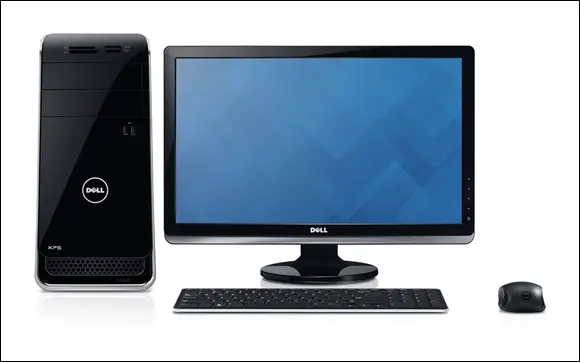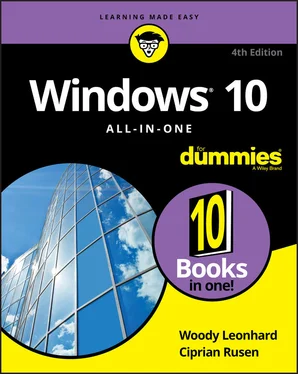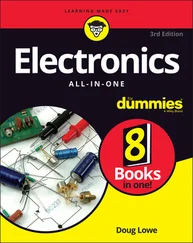Go overboard with hard drives. In the best of all possible worlds, get a computer with a solid-state drive (SSD) for the system drive (the C: drive) plus a large hard drive for storage, perhaps attached via a USB cable. For the low-down on SSDs, hard drives, backups, and putting them all together, see the upcoming section “ Managing disks and drives.” How much hard drive space do you need? How long is a string? Unless you have an enormous collection of videos, movies, or songs, 1TB (=1,024GB = 1,048,576MB = 1,073,741,824KB = 1,099,511,627,776 bytes, or characters of storage) should suffice. That’s big enough to handle about 1,000 broadcast-quality movies. Consider that the printed collection of the US Library of Congress runs about 10TB.If you’re getting a laptop or Ultrabook with an SSD, consider buying an external 1TB or larger drive at the same time. You’ll use it. External hard drives are cheap and plug-in easy to use.Or you can just stick all that extra data in the cloud, with OneDrive, Dropbox, Google Drive, or some competitor. See Book 6, Chapter 1to get started. For what it’s worth, I used Dropbox in every phase of writing this book.
Everything else they try to sell you pales in comparison.
 If you want to spend more money, go for a faster Internet connection and a better chair. You need both items much more than you need a marginally faster, or bigger, computer.
If you want to spend more money, go for a faster Internet connection and a better chair. You need both items much more than you need a marginally faster, or bigger, computer.
In this section, I give you just enough information about the inner workings of a desktop or laptop PC that you can figure out what you have to do with Windows 10. In the next section, I talk about touch-enabled tablets, the PCs that respond to touch. Details can change over time, but these are the basics.
The big box that your desktop computer lives in is sometimes called a CPU, or central processing unit (see Figure 1-5). Right off the bat, you’re bound to get confused, unless somebody clues you in on one important detail: The main computer chip inside that big box is also called a CPU. I prefer to call the big box “the PC” because of the naming ambiguity, but you’ve probably thought of a few better names.
The big box contains many parts and pieces (and no small amount of dust and dirt), but the crucial, central element inside every PC is the motherboard. (You can see a picture of a motherboard here: www.asus.com/Motherboards/PRIME-X570-PRO/ ).

Courtesy of Dell Inc.
FIGURE 1-5:The enduring, traditional big box.
You find the following items attached to the motherboard:
The processor, or CPU: This gizmo does the main computing. It’s probably from Intel or AMD. Different manufacturers rate their processors in different ways, and it’s impossible to compare performance by just looking at the part number. Yes, Intel Core i7 CPUs usually run faster than Core i5s, and Core i3s are the slowest of the three, but there are many nuances. The same is true for AMD’s Ryzen 7, Ryzen 5, and Ryzen 3 line-up of processors. Unless you tackle intensive video games, create and edit audio or video files, or recalculate spreadsheets with the national debt, the CPU doesn’t count for much. If you’re streaming audio and video (say, with YouTube or Netflix) you don’t need a fancy processor. If in doubt, check out the reviews at www.tomshardware.com and www.anandtech.com .
Memory chips and places to put them: Memory is measured in megabytes (1MB = 1,024KB = 1,048,576 characters), gigabytes (1GB = 1,024MB), and terabytes (1TB = 1,024GB). Microsoft recommends a minimum of 2GB of RAM. Unless you have an exciting cornfield to watch grow while using Windows 10, aim for 4GB or more. Most computers allow you to add more memory to them. Boosting your computer’s memory to 8GB from 2GB makes the machine snappier, especially if you run memory hogs such as Microsoft Office, Photoshop, or Google Chrome. If you leave Outlook open and work with it all day and run almost any other major program at the same time, 8GB is a wise choice. If you’re going to do some video editing, gaming, or software development, you probably need more. But for most people, 8GB will run everything well.
Video card: Most motherboards include remarkably good built-in video. If you want more video oomph, you must buy a video card and put it in a card slot. Advanced motherboards have multiple PCI-Express card slots, to allow you to strap together two video cards and speed up video even more. If you want to run a VR or AR headset, such as an Oculus Rift, you’re going to need a much more capable video setup. For more information, see the “ Screening” section in this chapter.
SSD: Solid-state drives, or SSDs, are fast and cheap storage. You don't have to buy an expensive drive to benefit from tangible speed improvements. If you don't want to wait a long time for your programs to load and don’t want Windows 10 to take minutes to boot, buying an SSD is a must. In comparison, hard disks (HDDs) are slow and dated. You should use an HDD for storing your personal files and backing up your data, not for running Windows 10, games, and apps.
Card slots (also known as expansion slots): Laptops have limited (if any) expansion slots on the motherboard. Desktops generally contain several expansion slots. Modern slots come in two flavors: PCI and PCI-Express (also known as PCIe or PCI-E). Many expansion cards, such as video cards, sound cards, and network cards, require PCIe slots. Of course, PCI cards do not fit in PCIe slots, and vice versa. To make things more confusing, PCIe comes in four sizes — literally, the size of the bracket and the number of bumps on the bottoms of the cards is different. The PCIe 1x is smallest, the relatively uncommon PCIe 4x is considerably larger, and PCIe 8x is a bit bigger still. PCIe 16x is just a little bit bigger than an old-fashioned PCI slot. Most video cards these days require a PCIe 16x slot. Or two.If you’re buying a monitor separately from the rest of the system, make sure the monitor takes video input in a form that your PC can produce. See the upcoming section “ Screening” for details.
USB (Universal Serial Bus) connections: The USB cable has a flat connector that plugs into your slots. USB 3 is considerably faster than USB 2, and any kind of USB device can plug into a USB 3 slot, whether the device itself supports USB 3 level speeds.USB Type-C (often called USB C) is a different kind of cable that has a different kind of slot. It has two big advantages: The plug is reversible, making it impossible to plug it in upside-down, and you can run a considerable amount of power through a USB-C, making it a good choice for power supplies. Many laptops these days get charged through a USB C connection.Make sure you get plenty of USB slots — at least two, preferably four, or more. Pay extra for a USB C slot or two. More details are in the section “ Managing disks and drives,” later in this chapter.
Lots of other stuff: You never have to play with this other stuff unless you’re very unlucky.
Here are a few upgrade dos and don’ts:
Don’t let a salesperson talk you into eviscerating your PC and upgrading the CPU: Intel Core i7 isn’t that much faster than Intel Core i5, and a 3.0-GHz PC doesn’t run a whole lot faster than a 2.6-GHz PC. The same is true for AMD’s Ryzen 7 versus Ryzen 5.
When you hit 8GB in main memory, don’t expect big performance improvements by adding more memory, unless you’re running Google Chrome all day with 42 open tabs, or putting together videos.
Читать дальше

 If you want to spend more money, go for a faster Internet connection and a better chair. You need both items much more than you need a marginally faster, or bigger, computer.
If you want to spend more money, go for a faster Internet connection and a better chair. You need both items much more than you need a marginally faster, or bigger, computer.











